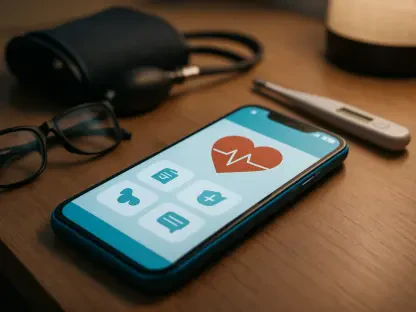In a startling revelation that underscores the fragility of modern healthcare systems, over one million Internet of Things (IoT) devices critical to patient care are exposed to potential cyberattacks across the globe, highlighting a dire need for enhanced security measures. These devices, ranging from MRI machines to infusion pumps and patient monitoring systems, form the backbone of digital health but are alarmingly susceptible to hacks due to inadequate security measures. A recent report by cybersecurity firm Modat has brought this crisis into sharp focus, revealing that such vulnerabilities jeopardize not only sensitive patient data but also physical well-being. With the healthcare industry increasingly reliant on connected technology for everything from remote diagnostics to real-time treatment, the risks posed by unsecured devices are a pressing concern. This growing threat serves as a stark reminder that innovation must be matched with robust protection to safeguard lives and trust in medical systems. The scale of this issue demands immediate attention from providers, regulators, and technology developers alike.
Uncovering the Scale of the Crisis
The magnitude of the cybersecurity challenge facing healthcare is staggering, with Modat’s findings indicating that over 1.2 million IoT devices are vulnerable worldwide. The United States bears the heaviest burden, accounting for more than 500,000 of these exposed devices, while nations like South Africa and Australia also grapple with significant numbers. Many of these tools operate on outdated protocols such as DICOM for medical imaging, often lacking basic encryption or secure authentication. This leaves them open to exploitation through simple tactics like accessing open ports or using default passwords. Hackers can easily infiltrate systems to steal personal health records, view medical scans, or monitor real-time data, posing a direct threat to patient privacy. The sheer volume of at-risk devices highlights a global problem that transcends borders, urging a coordinated response to address what has become a pervasive weak spot in healthcare infrastructure.
Beyond the numbers, the nature of these vulnerabilities paints a troubling picture of systemic neglect in securing critical medical technology. Devices like smart pacemakers and insulin pumps, essential for life-saving care, often run on unupdated firmware, creating easy entry points for malicious actors. The reliance on legacy systems, incompatible with modern security patches, exacerbates the issue, as does the widespread use of unchanged factory settings for access credentials. Reports suggest that hackers could exploit these flaws not just for data theft but to disrupt healthcare delivery on a massive scale. Social media discussions on platforms like X reflect public alarm over these risks, with users pointing to past data leaks and systemic failures as evidence of a deeper crisis. This exposure is not merely a technical glitch but a profound challenge that could undermine confidence in digital health solutions if left unaddressed.
Exploring the Underlying Weaknesses
At the heart of this cybersecurity crisis lies a troubling prioritization of efficiency over safety within the healthcare sector. Many facilities, driven by the need for seamless connectivity to improve patient outcomes, deploy IoT devices without adequate safeguards. Legacy systems, often decades old, cannot support contemporary security updates, leaving them riddled with unpatched vulnerabilities. Default passwords—sometimes as basic as “admin”—remain unchanged in countless devices, offering cybercriminals a straightforward path to access. Security researcher Himaja Motheram has emphasized that this cultural tendency to value operational speed over protective measures is a significant barrier to progress. Until healthcare providers shift their mindset to treat cybersecurity as a core component of patient care, these weaknesses will persist, endangering both data integrity and human lives.
Further compounding the problem is the lack of standardized security practices across the industry. Many organizations fail to implement routine firmware updates or conduct regular vulnerability assessments, often due to budget constraints or a lack of technical expertise. The use of outdated communication protocols, which were never designed with modern threats in mind, adds another layer of risk to an already fragile ecosystem. This patchwork approach to security creates inconsistent defenses, where a single weak link—such as an unsecured infusion pump—can compromise an entire network. The consequences of such lapses are evident in historical breaches that exposed millions of patient records, illustrating how technical shortcomings intersect with organizational failures. Addressing these root causes requires not just technological solutions but a fundamental change in how healthcare institutions view and manage their digital assets.
Assessing the Devastating Impacts
The potential fallout from these vulnerabilities extends far beyond compromised data, striking at the very core of patient safety. Hackers gaining access to IoT devices could manipulate critical settings, such as altering drug dosages in infusion pumps or disrupting the functionality of ventilators, with potentially fatal results. Past incidents, like a major breach in 2023 that exposed millions of health records, demonstrate the profound human and financial toll of such attacks. These events erode public trust in healthcare systems, as patients fear their most sensitive information could be exploited for fraud or identity theft. The ripple effects are immense, with providers facing costly lawsuits and reputational damage that can take years to repair. This intersection of digital and physical harm marks a new frontier in cyberthreats that demands urgent mitigation.
Moreover, the societal impact of these risks is amplified through public discourse on platforms like X, where outrage over systemic lapses in patient safety continues to grow. Massive data exposures, including leaks of mental health records, have fueled concerns about privacy in an era where personal information is increasingly digitized. For healthcare providers, the stakes are equally high, as regulatory penalties and multimillion-dollar settlements loom large in the aftermath of breaches. The dual threat of data theft and life-threatening device tampering underscores the urgency of addressing these vulnerabilities. Patients, already vulnerable due to their reliance on medical technology, face delayed care or falsified data from hacked wearables, further complicating treatment. This multifaceted crisis reveals how deeply cybersecurity is intertwined with the ethical responsibility to protect those under medical care.
Navigating Systemic Challenges and Rising Threats
Healthcare stands as a prime target for cybercriminals, generating 30% of the world’s data—a figure that doubles every two years. This explosive growth, coupled with the expanding role of telemedicine and connected devices, significantly heightens exposure to attacks. IoT tools enable remote monitoring and personalized care, but their integration into sprawling, often unsecured networks creates countless points of failure. Industry experts stress that these vulnerabilities are not isolated incidents but symptoms of systemic issues, including outdated technology and a persistent underestimation of security needs. The rapid pace of digital transformation in medicine has outstripped the development of protective measures, leaving critical systems exposed to increasingly sophisticated threats that exploit both technical and human weaknesses.
Another alarming trend is the evolving nature of cyberthreats, which now pose risks to both privacy and physical health. While earlier attacks primarily focused on stealing records for financial gain, today’s dangers include direct interference with medical devices that could harm patients. This shift, highlighted by warnings from Modat and echoed in industry analyses, reframes IoT security as a fundamental patient safety concern. The reliance on connected technology for critical care means that a single breach could have cascading effects, disrupting entire healthcare networks and delaying life-saving interventions. Addressing this dual threat requires a comprehensive approach that goes beyond patching software flaws to tackle the broader cultural and operational barriers within the sector. Until these systemic challenges are met with decisive action, the healthcare industry remains perilously exposed to digital dangers.
Forging a Path Toward Stronger Defenses
Despite the grim outlook, actionable solutions exist to fortify healthcare IoT security, though their implementation remains uneven. Experts advocate for multi-layered strategies, including regular penetration testing to identify weaknesses, timely firmware updates to close known gaps, and network segmentation to limit the spread of breaches. Zero-trust architectures, which assume no device or user is inherently safe, are gaining traction as a way to enhance protection. However, cultural resistance within the industry—where many view IoT tools solely as efficiency boosters rather than security liabilities—slows progress. Overcoming this mindset is critical, as is fostering collaboration between healthcare providers and cybersecurity firms to build resilient systems capable of withstanding modern threats.
On the regulatory front, there are signs of movement, though disparities persist across regions. Europe’s stringent GDPR framework imposes heavy fines for security lapses, pushing organizations to prioritize data protection, while enforcement in the U.S. remains inconsistent. The healthcare IoT security market is expected to reach $3.52 billion by 2034, fueled by the demands of telemedicine, yet financial investment alone cannot solve the problem without broader adoption of best practices. Predictions suggest stricter regulations mandating device certification could emerge by 2026, offering a potential turning point. In the interim, providers must take proactive steps, such as partnering with experts to conduct risk assessments and integrating AI-driven anomaly detection to spot threats in real time. These measures, though challenging to implement, represent a vital step toward securing the digital future of healthcare.
Building a Secure Future for Digital Health
Reflecting on the exposure of over one million healthcare IoT devices to hacks, it becomes evident that the industry faces a profound reckoning with vulnerabilities driven by outdated systems and lax practices. The risks, placing countless patients in danger of data theft and physical harm, demand urgent action. Yet, amidst these challenges, a roadmap for improvement has emerged. Healthcare providers are urged to adopt robust defenses like network segmentation and zero-trust models, while regulators hint at tougher standards on the horizon. Partnerships with cybersecurity specialists and investments in AI-driven solutions offer practical ways to mitigate dangers. The lessons from this crisis point to a clear imperative: balancing innovation with security is non-negotiable to protect the lives and trust at the core of medicine. Moving forward, the industry must commit to these actionable steps to ensure that digital health advancements no longer come at the cost of safety.









